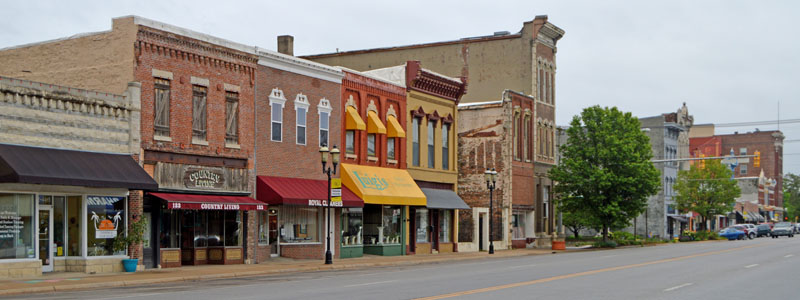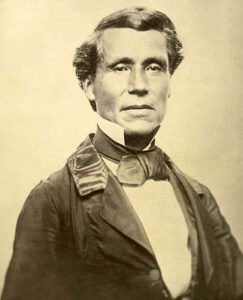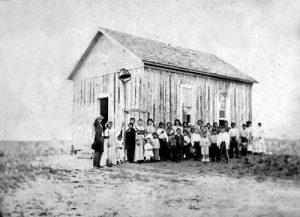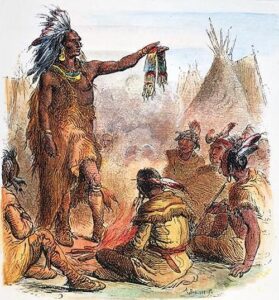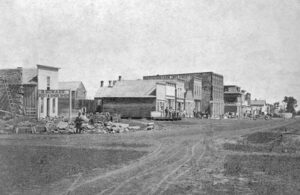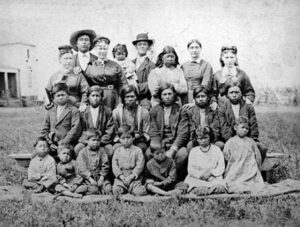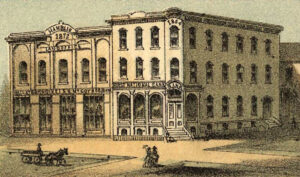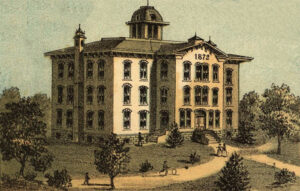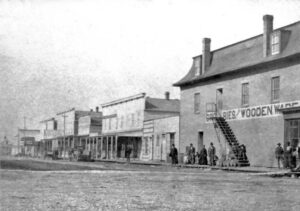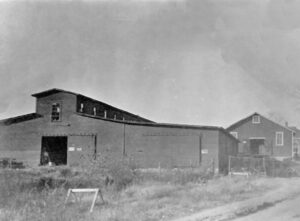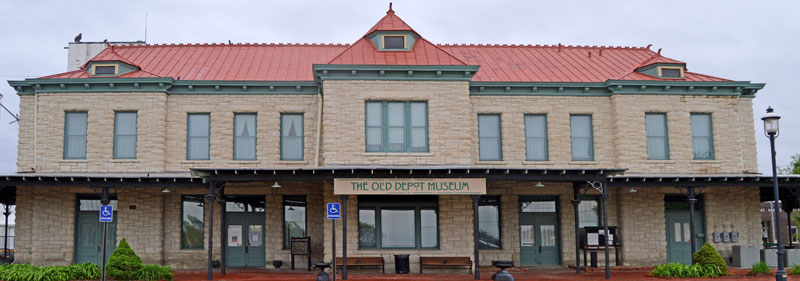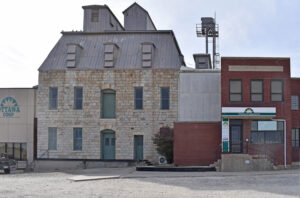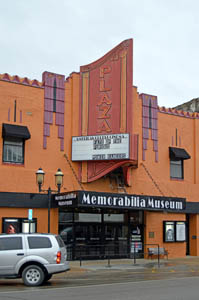Ottawa, Kansas, located on both banks of the Marais des Cygnes River, is the county seat of Franklin County. As of the 2020 census, the population of the city was 12,625. It is the home of Ottawa University.
Deriving its name from the Ottawa Indians, the city was laid out on the Ottawa Reservation.
This place started in 1832 when the Ottawa Tribe ceded their Ohio lands to the United States in return for 34,000 acres of what is now Franklin County. The Government appointed John Tecumseh Jones to assist the tribe in establishing itself on the new reservation. Jones was a half-breed Potawatomi Indian who had graduated from the Baptist Education Society, which later became Colgate University in New York.
Arriving in Kansas, the Ottawa found abundant game, grass, and water. However, the hot, dry air, an extreme contrast to the humid climate at their Ohio reservation, caused many to sicken and die. The Reverend Jotham Meeker of the Shawnee Mission, 60 miles to the northeast, traveled frequently to the ailing Indians, doctoring them as best he could. Finally, in the summer of 1837, he and his wife moved to the Ottawa reservation and established the Ottawa Indian Baptist Mission. As described by Meeker, they made their home in “a rough small cabin, intended for a stable and without a chimney, floor, or window.” Among the missionary’s meager possessions was an old Seth Adams press with which, at Shawnee Mission in 1835, he had printed the Shawnee Sun in the Shawnee language.
The Ottawa were a peaceful, intelligent people. Meeker taught them simple agricultural methods while his wife nursed the sick; together, they instructed the tribe in spelling, reading, and the gospel. On his press, Meeker printed the Laws Governing the Ottawa Indians, which many of the younger members of the tribe were soon able to read. Word of Meeker’s work reached neighboring Indians and aroused their curiosity.
Sac and Fox braves, clad in their finest regalia, would creep close to the mission, listen to the preacher’s music or voice, and then silently depart.
John Tecumseh Jones, or, as he was better known, Tauy Jones, was of great help to the Meekers, and in time, he became associated with them in their missionary work. In 1845, he married Jane Kelly, a white missionary. He was subsequently adopted into the Ottawa tribe, mainly because of the affection the Indians held for his wife.
When border warfare broke out, the Ottawa Indian Baptist Mission became a headquarters for Free-State advocates. Tauy Jones and the Reverend Meeker were staunch abolitionists. A two-story hotel that Jones built near the mission in the 1850s was burned by pro-slavery sympathizers in 1856. John Brown, a warm friend of Jones, told the Massachusetts Legislature of this event in 1857: “I saw it while it was still standing, and afterward saw the ruins of the most valuable house and property of a highly civilized, intelligent, and exemplary Indian, which was burned to the ground by the ruffians.”
Incoming settlers found the site of Ottawa highly desirable because of a natural ford at that point across the Marais des Cygnes River. The land belonged to the Indians, however, and a settlement was not at once established. In March 1864, I. S. Kalloch, a Baptist preacher; C.C. Hutchinson, an Ottawa Indian Agent; James Wing, Ottawa Chieftain; and Tauy Jones obtained the desired tract through their positions as members of the recently formed Ottawa University Board of Trustees. Through a treaty connected to the founding of Ottawa University, the Ottawa Tribe donated 20,000 acres of land to establish and fund a school for educating Indians and non-Indians alike.
A town company was immediately organized, with C. C. Hutchinson, then Indian Agent, and I. S. Kalloch as leading spirits, and including in its number James Wind, the Ottawa Chief, and John T. Jones, then minister, Asa S. Lathrop, the company’s surveyor and attorney, and a few non-resident politicians and capitalists. The early arrivals pitched tents for accommodation.
After the survey, J.C. Richmond, on the last day of March, raised the first house in the new town, on the corner of Walnut Street, and First on March 31, 1864. A post office was established the same day C.T. Evans was appointed Postmaster.
Shortly after its establishment, Ottawa was damaged by a tornado. Describing it, an early settler, A.F. Richmond, stated, “I could see the cyclone coming. It looked like a ball of fire, and it roared like thunder. It would go up in the sky and come down again. Whenever it hit the ground, it made explosions like a cannon. There was a long tail on that cyclone that revolved. It came down and hit the front of our house, took off all the doors and windows in the front, destroyed all the furniture in the front room, and filled the room with old pieces of bottles, old tin cans, old worn-out shoes, and boots, bric-a-brac, pieces of iron, dead cats and dogs.”
Under the company’s liberal policy, the settlement grew rapidly.
J.H. Whetstone brought a valuable sawmill where lumber was cut for the first dwellings and business houses. The Ottawa House, which in the following years, served as a hotel and post office, stable, and railroad depot, was erected. The old capitol building was torn down at Minneola, removed To Ottawa, and located on the corner of Second and Main Streets, where G. S. Holt opened the first dry goods store. A part of the first floor was used for office purposes, and the second floor was finished as a large hall known as Lathrop’s, where public meetings, entertainment, Baptist church services, and courts were all held. The building was later converted into a hotel known as the Wilkerson House.
In July, the County Commissioners erected the Chippewa and Ottawa Reservations into a township under the name of Franklin Township.
On August 1, 1864, Ottawa was made the county seat of Franklin County by popular vote. The county officers at the time were C. L. Robbins, Sheriff; H. F. Sheldon, County Clerk and Register of Deeds; John Malruff, County Treasurer; and H. P. Welsh, Jacob Sumstine, and Mr. Bicketts, County Commissioners. Among other notables early on the ground should be mentioned P. P. Elder, C. A. Bunting, G. W. Beeman, Judge Valentine, James Davis, E. J. Nugent, and D. W. Zimmerman, who, without special capital but with indomitable pluck, carried to completion two years later the Luddington Hotel.
In January 1865, the first locomotive of the Leavenworth, Lawrence & Galveston Railroad arrived in Ottawa. The first newspaper in the town was the Western Home Journal, which appeared in June 1865. Owned and edited by I.S. Kalloch, it was widely circulated and, by judicious advertising, was instrumental in attracting settlers to the town. In the following years, many fine buildings were erected, the machine shops secured, and a steam fire engine was purchased.
In 1866, Ottawa was incorporated, and the control of municipal affairs passed from the town company to a board of trustees. That fall, a brick public school building was built on Walnut Street for $30,000. Mary Ward was hired as a teacher for $50 per month, and Lottie Meyers was an assistant teacher. That year, under the Trustees of Ottawa University, two college departments were started, including an Indian school on Hickory and Second Streets, with 40 students, and an advanced grade for the whites in the Cumberland Presbyterian Church on Main Street.
After Ottawa was incorporated, the City Council granted the first license to sell intoxicating drinks. Some good citizens suspected the city government was formed for that purpose because a license could not be obtained under the former government. The outcome of it added nothing to the sobriety or orderliness of the village but considerable to its budget of expenditures.
After 1866, Ottawa’s population increased rapidly, and more schoolrooms were soon needed. The Cumberland Presbyterian Church was rented and, after a few years, purchased by the Board of Education. The Whetstone Building on Main Street was also rented immediately north of the Marias des Cygnes River.
During the winter of 1866-67, a bridge company organized for that purpose constructed the fine suspension bridge at the foot of Main Street. They operated it as a toll bridge until the city purchased it eight years later and made it free.
A treaty to move the Ottawa to Indian Territory in Oklahoma was signed on February 23, 1867. As the Indians vacated the region, white settlers flocked in, and Ottawa prospered.
That year, a substantial two-story stone courthouse was erected after the county voted $20,000 in bonds. A jail was also built. Courthouse Square on Main Street was a little south of the business center.
The Ottawa Mill, a substantial stone flouring mill, was erected by James Davis on Main and First Streets and was first run by Kirby & Wright. Crane & Wightman afterward enlarged it and added an elevator. The mill had four runs of buhrs, with the capacity to manufacture 20,000 pounds daily. The elevator also had a storage capacity of 15,000 bushels.
In October 1867, Ottawa was incorporated as a city of the second class, and the first city election was held on November 30 of that year, when Asa S. Lathrop was elected the city’s first mayor.
In January 1868, the first train ran into the town over the Leavenworth, Lawrence & Galveston Railroad, and a period of development and activity ensued. The Kansas City & Santa Fe reached Ottawa in 1870, and other roads followed. Several fine business blocks were erected; machine shops and a fire department were established; and a larger and better-equipped public school building was completed for $30,000.
The Ottawa Furniture Company was organized in 1870 with a capital stock of $16,000. Though initially unprofitable, it soon corrected, and its goods were first-class and extensively sold throughout Kansas and Texas. It employed 35 men.
The First National Bank of Ottawa grew out of the well-known private bank of P. P. Elder & Co., which was started in 1866 at the southwest corner of Main and Second Streets. It became a national bank in 1870 with a capital of $50,000. In 1875, A.M. Blair and H. J. Smith bought most of the stock and merged into a private bank, becoming president and Smith as the cashier.
In 1871, the community voted $60,000 and donated a site valued at $70,000 to assure the establishment of the machine shops of the Leavenworth, Lawrence & Galveston Railroad. Located in the northern part of the city, the solid stone shops were erected next year for $100,000 for building and machinery. The main shop was 110 by 116 feet, 22 feet high. There was a wing 60 by 120 feet, two offices, a store room, and an engine house 63 feet deep, having 14 stalls. The shops employed about 200 men, with a monthly payroll of $9,000. T. D. Volh was the master machinist; John Johnson was the general foreman; J. E. Lindzy was the foreman of the car shop; Moses Mitchell was the foreman of the blacksmith shop; and W.H. Hodge was the foreman of the paint shop.
The People’s National Bank of Ottawa commenced business on January 1, 1872, with H.H. Lugington as president and B.C. McQuesten as cashier. It enjoyed ten years of uninterrupted success, garnering a large business from Franklin, Osage, Miami, Anderson, and Coffey Counties. By the early 1880s, its deposits were $200,000, and cash capital and surplus fund were $70,000.
In the spring of 1872, the school district voted to issue $30,000 in bonds to build a new public and high school building. It was a three-story, brick, 12-room building above a stone basement completed without issuing additional bonds. The school was opened in this building in April 1873.
The Ottawa Oil Mill, located just north of the river on Walnut Street, was owned and operated by G.T. Potter. It began operation in 1873 with $9,000 capital invested. It had one hydraulic press with a power of 500 tons. Three barrels of oil, either linseed or castor, were manufactured daily.
The Forrest Mill, situated on Walnut Street, south of the river, was a large frame structure built by O. W. Baldwin and Frank Pope for $25,000. A dam and elevator were added in 1875 for $15,000. Water was mainly used as power, but steam was used in emergencies. There were five runs of buhrs, manufacturing 125 barrels of flour daily. The storage accommodations were 27,600 bushels. John Kinneard and J. P. Laird, the owners and manufacturers, made extensive and costly improvements in1882, with about $15,000 being expended on new machinery.
In 1876, the Ottawa House became the Wilkerson House and was moved across the alley, where it was used as a hotel.
The Excelsior Mill is the name of the superb flouring establishment erected on Main and Tecumseh Streets in 1881. It was of plain but massive architectural proportions and equipped within and without the best modern appliances and machinery. The cost was about $38,000. There were seven runs of buhrs. I manufactured 120 barrels of flour daily. H. D. Crane, J. B. Shaffer, and William Shires own and operate the mill under the firm name of H. D. Crane & Co.
The Franklin County Foundry, situated on the south bank of the river at the foot of Main Street, was owned and carried on by S.D. Clark was a most capable and ingenious machinist. The two-story building measured 50×50 feet, with an annex for the engine. The railroad shops made large demands for his castings. Twenty men were employed.
A Furniture Factory and Saw and Planing Mill was established in August 1882 on Hickory Street, just south of the river, by J. Jeffries & Co. The principal building was a two-story frame measuring 36 by 60 feet. There was also an attached large stone drying room and an engine room. The factory employed ten men.
By the early 1880s, Ottawa’s residential section was mainly composed of frame houses behind broad lawns shaded by mature elms. Main Street bound the community together physically by spanning the river and economically because of the shops packed tightly along its south extent.
At that time, Ottawa manufactured flour, ice cream, farm machinery, and electric refrigerators. There were several hatcheries, two mail-order printing houses, a stone-crushing plant, and a foundry and woodwork factory. The Atchison, Topeka & Santa Fe Railroad maintained car shops and a division headquarters. Water and light facilities were municipally owned.
The city also had three parks within its limits, including Forest Park, containing 40 acres north of the river. College Park was situated in the southern part of the city and contained 16 acres, and the Courthouse Park occupied the block between Third and Fourth Streets, the building facing Main Street. At that time, the town also boasted three fine halls, four large hardware stores, two stove, and tin shops, 11 dry goods stores, 20 grocery stores, three clothing stores, three boot and shoe stores, two book stores, a drug store, four millinery shops, three jewelry stores, four confectionery and bakery establishments, five stables, seven hotels, a billiard saloon, half a dozen eating houses, and three extensive lumber yards. It also supported 11 lawyers, as many doctors, four dentists, a score of real estate and insurance men, a private banker, some street brokers, and a population of 5,000.\
Electricity was generated in Ottawa in 1888, less than four years after New York City’s Pearl Street Station, the first plant in the country to produce electricity for public use, had been put in operation. Following a year of experimentation, the Ottawa plant began supplying power for public use in 1889. A field of natural gas was discovered near the city in the opening decade of the present century and harnessed for commercial use. Several industries were established after that; brick structures replaced false frame fronts on Main Street, and by 1910, the population stood at 7,500.
In 1892, another courthouse was built. Architect George P. Washburn designed the red brick building in the Romanesque Revival style with four square corner towers and two cupolas on the roof, including a bell tower and a clock tower. The east and west entrances to the courthouse are through large porches supported by brick columns and topped with balconies. The courthouse was added to the National Register of Historic Places on March 17, 1972.
In 1910, Ottawa was located on the Atchison, Topeka & Santa Fe, and the Missouri Pacific Railroads. With the development of the natural gas fields, gas was piped to Ottawa, which led to an increase in the number of factories. At that time, Ottawa was one of the most prosperous cities in the eastern part of the state, with electric lighting, waterworks, and telephone systems, several grain elevators, flour mills, furniture factories, a large creamery, brick, and tile factories, several machine shops and a soap factory, and a population of 7,650.
With a history of flooding because of its location straddling the Marais Des Cygnes River, a flood crested at 38.65 feet and killed six people in 1928.
In 1943, German and Italian prisoners of World War II were brought to Kansas and other Midwest states to help solve the labor shortage caused by American men serving in the war. Large internment camps were established in Kansas, including Camp Concordia, Camp Funston at Fort Riley, and Camp Phillips in Salina under Fort Riley. Fort Riley also established 12 smaller branch camps, including one in Ottawa.
Another flood, cresting at 31 feet, occurred in 1944. The Great Flood of 1951 was the worst. It crested at about 43 feet, covering one-third of the city. The Great Flood affected much of Missouri and Kansas, and 41 people died. Afterward, the U.S. Army Corps of Engineers built a series of levees and pumping stations as part of a more extensive system to regulate the Marais Des Cygnes River to the Missouri River.
Ottawa has a total area of 9.42 square miles, of which 9.32 square miles is land and 0.10 square miles is water.
Today, Ottawa’s two major employers are Walmart and American Eagle Outfitters, which maintain distribution centers in the city. Ottawa has a freight rail service from Burlington Northern Santa Fe Railway. The Ottawa Co-Op also operates a grain elevator. The city operates the Ottawa Municipal Airport, a small General Aviation airport four miles south of the city.
The community is served by Ottawa’s USD 290 public school district, which has five schools.
The private four-year university, Ottawa University, is within Ottawa, and Ottawa is also home to a branch campus of Neosho County Community College.
Ottawa, Kansas, located a little northeast of the county’s geographical center, is located 58 miles southwest of Kansas City at the junction of U.S. Route 59 and K-68. U.S. Route 50 and Interstate 35 bypass Ottawa to the south and east, while business US-50 passes through the city.
©Kathy Alexander/Legends of Kansas, updated January 2024.
Also See:
Early Indian Residents of Franklin County
Extinct Towns of Franklin County
Sources:
Blackmar, Frank W.; Kansas: A Cyclopedia of State History, Vol I; Standard Publishing Company, Chicago, IL 1912.
Cutler, William G; History of Kansas; A. T. Andreas, Chicago, IL, 1883.
Federal Writer’s Project, Kansas, A Guide to the Sunflower State, Viking Press, New York, 1939.
Wikipedia

